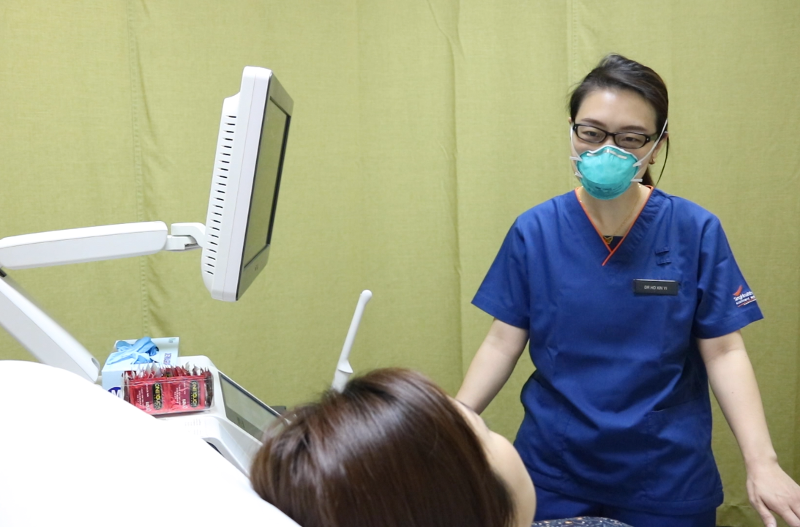
A clinician examines a pregnant patient at the KKH Urgent O&G Centre.
“Even during a pandemic, the need for safe and timely care remains undiminished,” says Associate Professor Tan Hak Koon, Chairman, Division of Obstetrics and Gynaecology, KK Women’s and Children’s Hospital (KKH).
To optimise safety in care for obstetrics and gynaecology (O&G) patients during COVID-19, KKH has published clinical practice recommendations and precautions taken by frontline obstetricians and healthcare professionals at the hospital. The recommendations include management of early pregnancy, general gynaecology, general obstetric care, labour and delivery. Read the full paper
here.
“As the largest maternity hospital in Singapore, we hope that this summary of the protocols and precautionary measures that we have put in place will be useful for other healthcare providers in guiding safety in O&G patient care,” shares Assoc Prof Tan, who is also a co-author of the published recommendations.
From the frontline: KKH Urgent Obstetrics and Gynaecology Centre
Report adapted from: Allison Tan CS, Lily Kho CL, MRCOG, Tan Shu Qi, Kathirvel R, Sulaiman S., (2020) In Response to COVID-19: Frontline Experience in a Tertiary Obstetrics and Gynaecology Hospital. J Women Health Care Issues. J Women Health Care Issues, 3(3); Doi:10.31579/2642-9756/031 Read the full paper
here.

The COVID-19 pandemic has presented a unique challenge to KKH’s Urgent Obstetrics and Gynaecology Centre (UOGC), requiring dynamic adaptation in maintaining continuity of care.
Visited by approximately 2,200 patients each month, the UOGC is a 24-hour walk-in centre for women with acute O&G issues, such as early pregnancy, post-partum, general gynaecology, urogynaecological, breast and gynaeoncological conditions.
“The pandemic has taught us that the response to an evolving outbreak is a dynamic one, and continued reassessment of processes and workflows is key to helping to curb the outbreak. The practical factor of logistics has been vital in enabling the UOGC team to maintain patient safety and continuity of care during extraordinary circumstances,” shares
Dr Suzanna Bte Sulaiman, Head and Senior Consultant, Department of Obstetrics and Gynaecology, KKH.
Precautionary measures for safety and quality of care
To prevent transmission, integrated precautionary measures have been implemented, including:
- Screening and triage protocols for patients and accompanying persons
- A designated isolation area that is physically separate from the main UOGC facility
- Negative pressure consultation rooms dedicated for the review of patients in isolation
- A segregated waiting area with safe distancing measures in place
- Dedicated imaging protocols and ultrasound equipment for patients in isolation
- Escorted movement protocols for patients in isolation
- Dedicated teams of medical staff working in rostered split shifts
- Support provided by a separate team of obstetricians, gynaecologists and infectious disease physicians
- Dedicated ambulance transfer for patients in isolation requiring hospital transfer
“We have further adopted additional safety precautions against droplet and airborne transmission in the form of enhanced personal protection equipment. Both medical and nursing team continuously remind each other about the importance of safety for self, colleagues and patients. This keeps our staff alert at all times,” shares
Dr Rajeswari Kathirvel, Head and Consultant, UOGC, KKH.
Swab and Send Home protocol
A Swab and Send Home (SASH) protocol is also in place for patients with fever or acute respiratory symptoms who do not have active gynaecological issues requiring admission.
“The SASH protocol eliminates the need for hospital admission for these stable patients requiring COVID-19 swab testing. Instead, they are issued a five-day hospitalisation leave, during which they are to remain isolated at home by law. Patients are given clear discharge advice defining precautionary measures to take, and instructed to return for further medical attention should their condition worsen. Swab results are communicated to the patients in a timely fashion,” adds Dr Rajeswari.
Dynamic adaptation to maintain continuity of care
For Dr Suzanna, Dr Rajeswari and the UOGC team, continued vigilance is vital as the situation continues to evolve.
Says Dr Suzanna, “This crisis has challenged and strengthened the centre’s ability to respond swiftly to an evolving pandemic. We continue to work closely with our colleagues from the Infectious Disease Service and reassess and review our processes and workflows in place, to curb this outbreak and to prepare for the future.”
Keep Healthy With
© 2025 SingHealth Group. All Rights Reserved.




















